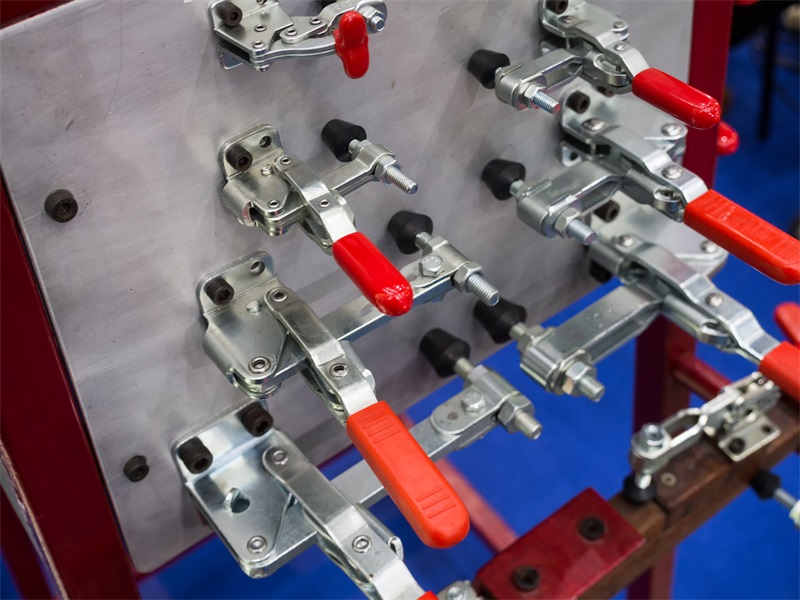The role of machine tool fixtures in machining
When processing the workpiece, in order to ensure the processing requirements, first of all, the workpiece must have the correct position relative to the tool and the machine tool, and this position should not be changed due to the influence of external forces during the processing. To this end, before machining, the workpiece must be clamped first.
There are two methods of clamping the workpiece: one is that the workpiece is directly clamped on the table or faceplate of the machine tool; the other is that the workpiece is clamped on the fixture.
When using the first method to clamp the workpiece, generally draw a line on the surface of the workpiece according to the requirements of the drawing, and mark the size and position of the machined surface. This method does not require special equipment, but has low efficiency and is generally used in small batch production. When the batch is large, most of the workpieces are clamped with clamps.
Clamping workpieces with fixtures has the following advantages:
(1) It can stably guarantee the machining accuracy of the workpiece. When the workpiece is clamped with a fixture, the positional accuracy of the workpiece relative to the tool and the machine tool is guaranteed by the fixture, which is not affected by the technical level of the workers, so that the machining accuracy of a batch of workpieces tends to be consistent.
(2) It can improve labor productivity. It is convenient and fast to use the fixture to clamp the workpiece, and the workpiece does not need to be aligned, which can significantly reduce auxiliary man-hours and improve labor productivity; after the workpiece is clamped in the fixture, the rigidity of the workpiece is improved, so it can be increase the cutting amount, Improve labor productivity; multi-piece, multi-station clamps can be used to clamp workpieces, and high-efficiency clamping mechanisms can be used to further improve productivity.
(3) Can expand the scope of use of machine tools.
(4) Cost reduction After the use of fixtures in mass production, the production cost is significantly reduced due to the improvement of labor productivity, the use of workers with lower technical levels, and the decline of the scrap rate. The cost of fixture manufacturing is allocated to a batch of workpieces, and the added cost of each workpiece is very small, far less than the cost reduction due to improved labor productivity. The larger the batch of workpieces, the more significant the economic benefits obtained by using the fixture.
There are many kinds of machine tool fixtures, which can be classified from different angles
Commonly used classification methods are as follows.
1. According to the use characteristics of fixtures
(1) Universal fixtures Standardized fixtures that can process different workpieces within a certain range are called universal fixtures, such as three-jaw centering chucks, flat-mouth vices for machine tools, universal indexing heads, magnetic workbenches, etc. These fixtures are available as a dedicated factory-built attachment for machine tools and can be purchased as an option.
(2) Special fixture A fixture specially designed and manufactured for a certain process of a workpiece is called a special fixture. Special fixtures are generally used in mass production.
(3) Adjustable fixture Some components of the fixture can be adjusted or replaced to adapt to a fixture for processing various workpieces, which is called an adjustable fixture. It is also divided into general-purpose adjustable clamps and group clamps.
(4) Combination fixtures The fixtures that use standard combination fixture components and parts, which are specially assembled for a certain process of a workpiece, are called combination fixtures.
(5) Assembly jig A jig made of special standardized and serialized assembly jig is called an assembly jig. It has the advantages of the combined fixture, but it has higher precision, higher efficiency and compact structure than the combined fixture. It often has small hydraulic cylinders in its base plate and clamping parts. . Such fixtures are more suitable for use on CNC machine tools.
2. According to the machine tool used
the fixtures can be divided into lathe fixtures, iron bed fixtures, drilling machine fixtures, hall bed fixtures, gear machine tool fixtures, CNC machine tool fixtures, automatic machine tool fixtures, automatic line accompanying fixtures and other machine tool fixtures.
3. According to the clamping power source
the clamps can be divided into manual clamps, pneumatic clamps, hydraulic clamps, gas-liquid booster clamps, electromagnetic clamps and vacuum clamps according to the clamped power source.
the composition of machine tool fixtures Although there are many types and structures of machine tool fixtures, their composition can be summarized as the following parts.
1. Positioning device, the function of the positioning device is to make the workpiece occupy the correct position in the fixture.
2. Clamping device, the function of the clamping device is to compress and clamp the workpiece firmly to ensure that the workpiece will not leave the correct position occupied by external force during the processing.
3. Tool setting or guiding device, which is used to determine the correct position of the tool relative to the positioning element.4. the connecting element, the connecting element is the element that determines the correct position of the fixture on the machine tool.
5. The specific clamp of the clamp, specifically the basic part of the machine tool clamp.
6. Other devices or components, they refer to the devices or components set up in the fixture for special needs. When it is necessary to process multiple surfaces that are distributed according to a certain rule, an indexing device is often installed; for convenient and accurate positioning, a pre-positioning device is often installed; for large-scale fixtures, hoisting components are often installed.

